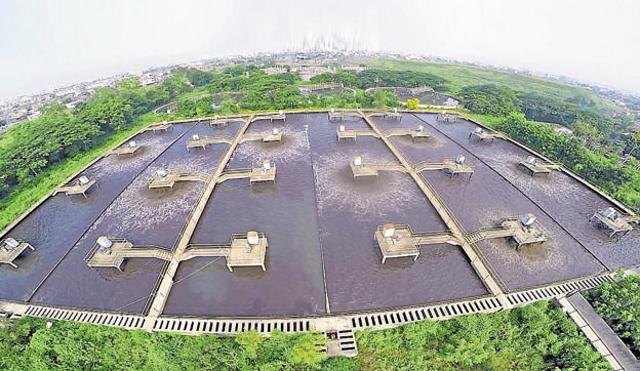
A special train carried around five lakh litres of water for parched Latur in Maharashtra’s Marathwada region in April this year. The first batch of 10 wagons, each with a capacity of around 50,000 litres, travelled a distance of around 350 kilometres to reach their destination where water was stored in a well located near the Latur railway station.
For 14 years now, arid Rajasthan has been using the railways to get water to its districts. This year since January, the state’s Public Health Engineering Department (PHED) has been running a 50-wagon train from Ajmer to Bhilwara daily, carrying 25 lakh litres.
While these steps are necessary, such measures might not have been required in the first place had these cities managed their water systems well. And with the smart cities list being announced, it’s time these cities took a smart look at their water management systems.
The first city to take the lead is Nagpur, Maharashtra. Now included in the smart cities list, it has a population of over 2.5 million people and is the first city of its size in the country to outsource water supply to a private operator under the PPP model for 25 years. Under the scheme the main objective was to provide 24-hour 100% safe drinking water to 100% population including slum dwellers within five years. The second objective was to reduce non-revenue water (50% water supplied to towns which is untraceable, not recorded and not paid for) to below 25% in 10 years. The project included management of the entire water cycle from production, treatment, transport, storage and delivery to the customer’s tap. It involved replacement of over three lakh house service connections, rehabilitation of treatment facilities, service reservoirs and pipelines.
“Now every household has a tap and a meter irrespective of whether it is a jhuggi, a flat or a bungalow. There is accountability for every drop of water supplied the first time,” says Arun Lakhani, chairman and managing director, Vishvaraj Infrastructure Ltd, which executed the Nagpur Orange City Water Project.
The aim of the project was to address problems of water that was being wasted and not getting billed. The city was supplying 575 million litres per day (mld) of treated water of which only 175 mld was getting billed and paid for. Most meters were either non-existent or non functional. Also, the city was receiving water supply for eight to 10 hours or on alternate days. The tanker mafia added to the problem. On the sewage side, the city was generating 550 mld of sewage and had the capacity to treat only 100 mld. The remaining untreated sewage was polluting water bodies that supplied water to the city.
For this project, the private company invested 30% of the estimated project cost, 70% grants came from the JNNURM scheme, shared by both the state and the Central government. The project was initiated by the Nagpur Municipal Corporation. This project has showcased as the model case study for other cities at the launch of Atal Mission for Rejuvenation and Urban Transformation (AMRUT) and Smart City initiative.
The company also undertook a waste water reuse project for Nagpur city under which National Thermal Power Corporation (NTPC) will be reusing 200 mld of treated water from the STP for its Mauda plant. By doing so, the city will get an additional 200 million litres per day of water, which is enough for 200 lakh people.
“Currently, the industrial sector, which is one of the biggest consumers of water, is supplied fresh treated potable water. They can easily use waste water treated up to the secondary level. As much as 80% of the water being supplied to cities is right there. It only needs to be treated and supplied to industries. Good potable water that industries get can be swapped for residential and drinking purposes,” says Lakhani.
Out of a 1,000 ml litre per day supplied to a town, nearly 800 mld is coming back as sewage. Out of this almost 500 mld can be treated and supplied to commercial complexes, industries, thermal power stations and water city parks. This can solve water shortage problems in almost every town, he says.
Faridabad in NCR is ideal for this kind of a project as the commercial base is huge. Supplying treated water to factories and industries will help the city manage its water requirements. It can also make the city cross subsidise drinking water for its citizens
Gurgaon’s water producing capacity is around 320 mld of water per day. With a population of 15 lakh, the consumption of water should not be more than 200 litres per day per person, yet the area has water scarcity. “The reason is that there is no accountability of water supplied, no maintenance of pipelines, no idea of what is being utilised and what is supplied and the amount that is being wasted.” he says.
The “Haryana Power Generation Corporation Limited is in discussions with us for possible use of sewage treated water for all the plants,” he says. Discussions are also on with Ghaziabad municipality and NTPC, Dadri, for supplying treated sewage water to the Dadri water plant.
The company has also bid for NDMC’s pilot 24×7 water distribution system. As for tackling Dwarka’s water plan, Lakhani suggests that packaged STPs with a capacity of supplying 10 lakh litres per day to Dwarka are the best solution. This facility can be set up within two weeks and can tap sewage from around the sub city.It has also offered solutions for watering cricket grounds and pitches wherein an STP set up on site to tap sewage and reuse the treated water.
Source:Hindustan Times

Leave a Reply